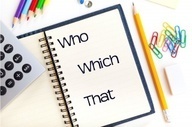Which. That. Who. Help!

I have been asked to write a blog post about which and that. Frankly, I would prefer to avoid that issue altogether and do something more enjoyable–—pulling weeds or cleaning my house, for example. But here goes…..
Which, who, and that introduce adjective clauses, which describe some noun in the sentence, usually the once preceding the clause. Here are some examples:
My uncle, who works in Hollywood, is coming to visit. (describes uncle)
The kids who are standing on the corner go to my school. (describes kids)
The dress that is in the window is beautiful and very expensive. (describes dress)
My car, which is in the garage, needs new brakes. (describes car)
The tribes that live in Connecticut are listed in Chapter 7. (describes tribes)
But now….when do you use which? that? who?
When do you use a comma around the clause and when don’t you?
Allow me to explain:
Which is generally used for things and animals, not for people.
Who is always used for people.
That can be used for people or things, but is generally used for things. That can be used for species or types of people.
Examples:
The car, which is in in the garage, needs new brakes.
My uncle, who is an actor, is visiting next month.
The book that is on the table is a bestseller.
The tribes that live in Connecticut are described in Chapter 7.
OK. Now, why are there sometimes commas around the clause and sometimes not?
Commas are used around nonessential clauses. These are clauses that could be left out without affecting the meaning of the sentence. The words in the clause are added information.
There are no commas around essential clauses. These clauses cannot be left out because they limit the noun they are modifying.
Examples:
The kids that are on the street corner go to my school. (The clause that are on the street corner tells which kids. You need that clause in the sentence, so you do not use commas around it.)
The kids on the street corner, who go to my school, are drawing on the sidewalk. (The clause who go to my school is added information. We already know which kids you are talking about. The clause can be thought of as “by the way, they go to my school.”)
Notice that for essential clauses (where there are no commas), that is generally used for things.
Also notice that for nonessential clauses (where the commas are used), which is generally used for things.
Who can be used with both essential and unessential clauses. Examples:
My brother, who goes to college in Georgia, is coming home for the summer.
The boy who is making the speech is the valedictorian. (need the clause to identify which boy)
Exceptions? Of course! You can sometimes use which without the commas (nonessential clauses). Examples:
She is taking the clothes which fit her the best and which don’t wrinkle. (If there are two nonessential clauses in the sentence, which is often used to introduce them.
That is a book which everyone should read. (If that is already used at the beginning of the sentence, which can be used.
Note that is is not wrong to use that in the above two examples.
So….to sum up:
Who is used for people.
Which is used for things.
That is usually used for things, but can be used for people, especially for types or groups.
Who is used both with and without commas.
Which is usually used with commas (added information).
That is usually used without commas (limits what is being talked about and usually is necessary for meaning of sentence).
Comments and questions are welcomed! If you are not a regular subscriber to the Grammar Diva Blog, why not sign up now?



